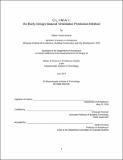| dc.contributor.advisor | Christoph Reinhart. | en_US |
| dc.contributor.author | Arsano, Alpha Yacob | en_US |
| dc.contributor.other | Massachusetts Institute of Technology. Department of Architecture. | en_US |
| dc.date.accessioned | 2017-09-15T14:22:39Z | |
| dc.date.available | 2017-09-15T14:22:39Z | |
| dc.date.issued | 2017 | en_US |
| dc.identifier.uri | http://hdl.handle.net/1721.1/111279 | |
| dc.description | Thesis: S.M. in Architecture Studies, Massachusetts Institute of Technology, Department of Architecture, 2017. | en_US |
| dc.description | This electronic version was submitted by the student author. The certified thesis is available in the Institute Archives and Special Collections. | en_US |
| dc.description | Cataloged from student-submitted PDF version of thesis. "June 2017." | en_US |
| dc.description | Includes bibliographical references (pages 64-65). | en_US |
| dc.description.abstract | One of the most widely discussed passive building design strategies is using natural ventilation for cooling. In addition to providing fresh air, which enhances occupant productivity and comfort, strategic implementation of natural ventilation in buildings reduces the energy needed for cooling. And this reduction in energy consumption significantly reduces carbon dioxide emissions. During the initial design phase, designers routinely use climate-file based analysis to evaluate the potential for comfort ventilation against other passive building strategies. Following this initial screening, it is customary to conduct detailed simulations to further develop design ideas. At this point, inconsistencies can arise between the early climate-file based analysis and later-stage simulations. Major differences arise from limitations of climate-file based analysis to account for influences of construction assemblies, building program, and occupant comfort preferences. This manuscript presents a building performance-based climate analysis method where quick, single-zone simulations are run in EnergyPlus. The ventilation cooling potential for a site and a building program is calculated using a series of Python scripts. | en_US |
| dc.description.statementofresponsibility | by Alpha Yacob Arsano. | en_US |
| dc.format.extent | 65 pages | en_US |
| dc.language.iso | eng | en_US |
| dc.publisher | Massachusetts Institute of Technology | en_US |
| dc.rights | MIT theses are protected by copyright. They may be viewed, downloaded, or printed from this source but further reproduction or distribution in any format is prohibited without written permission. | en_US |
| dc.rights.uri | http://dspace.mit.edu/handle/1721.1/7582 | en_US |
| dc.subject | Architecture. | en_US |
| dc.title | C L I M A + : an early design natural ventilation prediction method | en_US |
| dc.title.alternative | Early design natural ventilation prediction method | en_US |
| dc.type | Thesis | en_US |
| dc.description.degree | S.M. in Architecture Studies | en_US |
| dc.contributor.department | Massachusetts Institute of Technology. Department of Architecture | |
| dc.identifier.oclc | 1003490137 | en_US |

